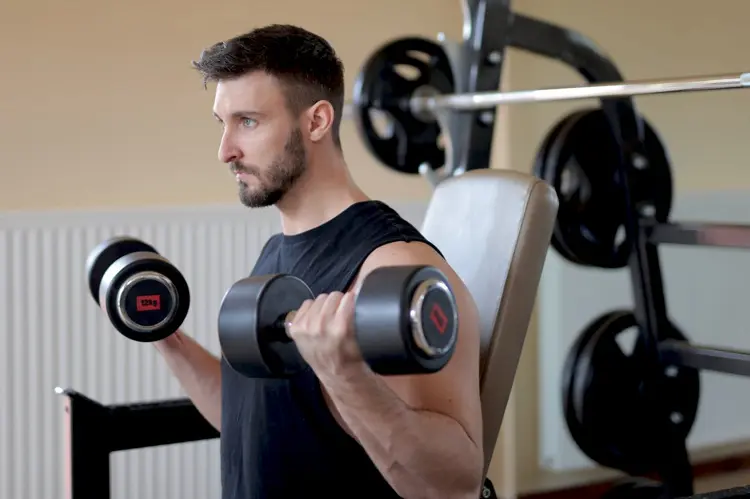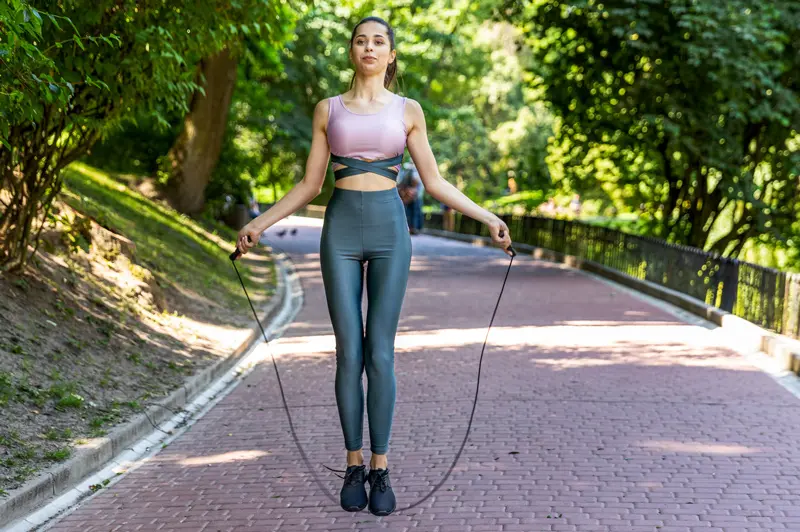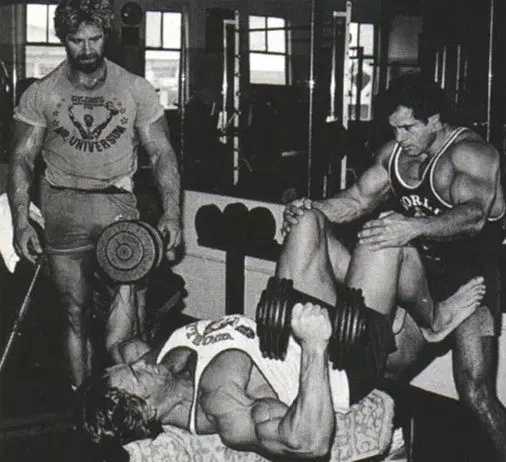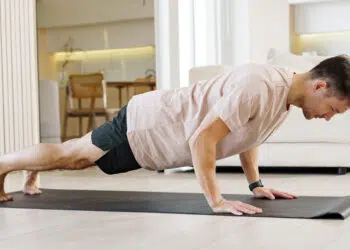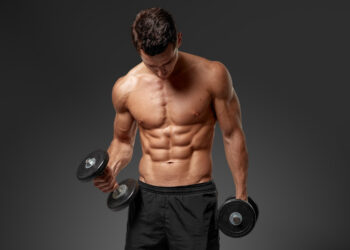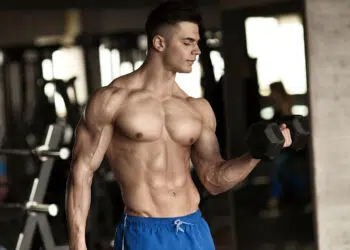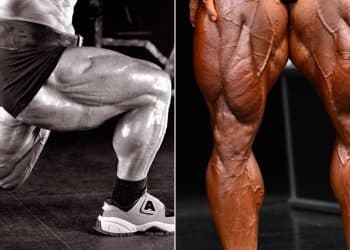I’ve been lifting weights for almost 40 years. During that time, I’ve experimented with almost every training tool you can imagine, from state-of-the-art electromagnetic strength training machines to rocks and logs.
And do you know what? They all worked in much the same way!
Provided you challenge your muscles with enough resistance, your body will respond by getting stronger and fitter. Muscles don’t care that you’re using a carefully calibrated barbell that cost $1500, or lifting a rusty dumbbell that you got for $15 at a garage sale. Despite the so-called mind-muscle connection, your muscles have a hard time differentiating between different training tools and methods.
As a veteran personal trainer with over three decades of professional experience, I can tell you that this is very good news. It means you can use almost any training tool to reach your training goals.
I often rely on dumbbells, especially for my home-training clients. In my opinion, dumbbells are one of the most practical and versatile training tools around. Whatever your training goal, dumbbells can help you achieve it.
In this article, I share one of my favorite dumbbell workout routines for building muscle at home.
Level Up Your Fitness: Join our 💪 strong community in Fitness Volt Newsletter. Get daily inspiration, expert-backed workouts, nutrition tips, the latest in strength sports, and the support you need to reach your goals. Subscribe for free!
The Advantages of Dumbbell Training
There is Nothing Dumb About Dumbbell Training! In fact, despite their name, dumbbells are actually a brilliant training tool. In some ways, are actually superior to barbells, resistance machines, and even bodyweight exercises.
Their advantages include:
Safety
Getting stuck under a heavy barbell during bench presses can cause serious injury. If you are able to complete your rep, you could end up with the barbell crushing your chest or neck. This is much less likely with dumbbells.
If you are unable to complete a rep, simply lower your weights down to the floor. You can’t do that with a barbell, and a failed rep of barbell bench presses can cause serious injury. Dumbbell squats are also potentially safer than barbell back squats.
Increased range of motion
With no bar to hit your chest or shoulders during rows and presses, you can move your joints through a larger-than-normal range of motion. This is good for joint mobility, flexibility, and muscle growth.
Fix left-to-right strength imbalances
Most people have one arm or leg that is stronger than the other. This is very normal. But, if that imbalance becomes too great, it can lead to postural abnormalities, lop-sided muscle development, and athletic performance issues. Training with dumbbells can highlight any imbalances and also provide you with the means to fix them.
Improve your balance and coordination
Lifting two weights instead of one will challenge your nervous system more than using a barbell or resistance machine. This will develop your balance and coordination. These fitness attributes are crucial in sports and can also help make everyday activities easier.
Variety
There are hundreds of different dumbbell exercises, and most of them can be performed using two hands, one hand, or even using an alternating arm action. Some exercises are only possible with dumbbells – there is no barbell equivalent. Using dumbbells, even if they are your only form of training, should never be boring!
So, if dumbbells (also spelled dumb-bells) are so good, why do they have the word dumb in their name?
Dumbbells are so-called because they were originally developed so that 18th-century English church bell ringers could practice their skills in silence and avoid disturbing the people nearby. They were literally ‘dumb’ ‘bells,’ dumb being an old-fashioned word for silent (1).
Dumbbell Disadvantages
For all their advantages and benefits, dumbbells have a couple of disadvantages too.
For pressing exercises, it can be difficult to get heavy dumbbells into the correct starting position. Also, for exercises like squats and deadlifts, barbells are usually easier to use.
That said, if you only have access to dumbbells, don’t worry too much about what you can’t do, and focus more on what you can. Ultimately, any exercise is better than no exercise, and you can still work all your major muscles using dumbbells.
Home Dumbbell Workout Routine
There are lots of different ways to organize your home workouts, from push/pull/legs to upper-body/lower-body. For this article, your workouts are:
- Legs
- Chest and back
- Shoulders and arms
While this is a very traditional split, it’s one I’ve had a lot of success with over the years. Do each workout once or twice per week to work all of your major muscles equally, i.e.:
- Monday – workout #1
- Wednesday – workout #2
- Friday – workout #3
Or
- Monday – workout #1
- Tuesday – workout #2
- Wednesday – workout #3
- Thursday – workout #1
- Friday – workout #2
- Saturday – workout #3
- Sunday – rest
Please note that the six-days per week training plan is only suitable for experienced/advanced exercisers who also have excellent recovery abilities. Beginners and intermediate exercisers should use the first option.
But, before you begin…
A good workout starts with a proper warm-up, and dumbbell training is no different. Prepare your body and your mind for training by doing a few minutes of light cardio, such as jumping rope.
Then, when you feel warm and slightly out of breath, do some dynamic stretches and joint mobility exercises for the body parts you’re about to train. Finally, do 1-2 sets of each exercise in your workout using a lightweight. You should now feel ready to work!
Workout #1: Dumbbell Leg Workout
No leg press machine or squat rack? No problem! Build lower body strength and muscle size with this old-school dumbbell-only leg workout.
| No. | Exercise | Sets | Reps |
| 1 | Goblet squat | 4 | 8 |
| 2 | Dumbbell Romanian deadlift | 4 | 10 |
| 3 | Bulgarian split squat | 3 | 12 |
| 4 | Dumbbell leg curl | 3 | 12 |
| 5 | Single-leg calf raise | 3 | 15 |
Exercise descriptions
1.1 Goblet Squat
Goblet squats work your quadriceps, hamstrings, and glutes. You only need one dumbbell to do this exercise. As well as being a great leg workout, goblet squats help reinforce the correct squatting technique. Best of all, you don’t need a squat rack to do them, so they’re ideal for home exercisers.
How to do it:
- Hold a dumbbell in front of your chest so that it’s vertical, and your palms are against the inside of the top weight plates. Step out and into a shoulder-width stance, toes turned slightly outward. Brace your abs and look straight ahead.
- Push your hips back, bend your knees, and squat down until your thighs are parallel to the floor. Do not round your lower back or bounce out of this lowermost position.
- Stand back up and repeat.
1.2 Dumbbell Romanian Deadlift
This exercise works your posterior chain, i.e., your hamstrings, glutes, and lower back. If you want to look as good from the rear as you do the front, this exercise is a must-do. Just take care not to round your lower back, as doing so could cause serious injury.
How to do it:
- Stand with your feet hip-width apart, knees slightly bent, and a dumbbell in each hand, held in front of your thighs.
- Push your hips back and hinge forward without rounding your lower back. Lower the weights down your legs to just below knee height.
- Push your hips forward and stand up, but do not lean back, as doing so puts too much stress on your lumbar spine.
1.3 Bulgarian Split Squat
This total-leg exercise is also good for hip mobility and overall balance. Working one leg at a time means you’ll be able to identify and fix any left-to-right strength imbalances you might have. This is an excellent exercise for athletes, especially runners.
How to do it:
Level Up Your Fitness: Join our 💪 strong community in Fitness Volt Newsletter. Get daily inspiration, expert-backed workouts, nutrition tips, the latest in strength sports, and the support you need to reach your goals. Subscribe for free!
- Stand with your back to a knee-high bench or chair. With a dumbbell in each hand, bend one leg and place your foot on the bench behind you. Hop forward and into a split stance.
- Bend your legs and lower your rearmost knee down toward the floor as far as your mobility allows. Lean forward slightly, but do not round your lower back.
- Stand back up and repeat. On completion, rest a moment and then do the same number of reps on the other leg.
1.4 Dumbbell Leg Curl
This dumbbell exercise is the old-school equivalent of the hamstring curl machine. It’s a little tricky, but once mastered, it will provide your hammies with a very effective workout. If your legs feel sore tomorrow, this exercise is the likely culprit!
How to do it:
- Lie on your front on a flat exercise bench. You can also do this exercise on the floor. Place and hold a dumbbell between your feet. Squeeze your legs together to keep it in place.
- Starting with your legs straight, bend your knees and curl your legs up until your shins are perpendicular to the floor.
- Extend your legs and repeat.
1.5 Single-Leg Calf Raise
This low-tech exercise will turn your calves into cows! It works both calf muscles; the soleus (the smaller, lower calf muscle) and the gastrocnemius (the larger, upper calf muscle.) Working one leg at a time ensures your muscles will receive the stimulus they need to get stronger and grow.
How to do it:
- Stand on one leg on a low, stable step so the ball of your foot is on the edge and your heel is free to move up and down. Hold a dumbbell in one hand. Use your free hand for balance.
- Lower your heel down toward the floor as far as your flexibility allows.
- Push up and onto your tiptoes. Raise up as high as you can.
Workout #2: Dumbbell Chest and Back Workout
Most gym-based workouts for the chest and back involve barbell bench presses and lat pulldowns. You’ll be glad to hear you can still work both of these crucial muscle groups using nothing more than your trusty dumbbells and an adjustable bench.
| No. | Exercise | Sets | Reps |
| 1 | Alternating incline dumbbell press | 4 | 10 |
| 2 | Renegade row | 4 | 10 |
| 3 | Dumbbell fly | 3 | 12 |
| 4 | Single-arm dumbbell row | 3 | 12 |
| 5 | Dumbbell fly, pullover, and press | 3 | 8 |
Exercise descriptions
2.1 Alternating Incline Dumbbell Press
This dumbbell exercise works your upper chest, anterior (front) deltoids, and triceps. The alternating arm action increases time under tension, making light and moderate weights feel heavy. This will be useful if you only have access to light dumbbells.
How to do it:
- Adjust your bench at a 30 to 45-degree incline. With a dumbbell in each hand, lie on it with your head uppermost. Press the weights up to arm’s length.
- Keeping one arm extended, bend the opposite arm, and lower the weight down to just outside your shoulder. Press it back up and then swap sides.
- Continue alternating sides for the duration of your set. Remember, one arm should always be straight and stationary.
2.2 Renegade Row
This lat, mid-traps, posterior deltoid and biceps exercise also works your core. Use light weights initially until you have mastered this tricky but rewarding move. The renegade row was invented by strength coach John Davis, who specializes in training pro football players.
How to do it:
- With a dumbbell in each hand, adopt the push-up position with your arms and legs straight, and your core braced. Your hands should be shoulder-width apart.
- Keeping your supporting arm straight, row one dumbbell up and into the side of your ribs.
- Lower the dumbbell back to the floor and then do a second rep on the opposite side.
- Continue alternating arms for the duration of your set.
2.3 Dumbbell Fly
The dumbbell fly provides an excellent way to isolate your chest. With minimal triceps involvement, this exercise is best done using light to moderate weights and using a slow, controlled tempo. You can also do this exercise on an incline bench to hit your upper chest more.
How to do it:
- Lie on a flat exercise bench with a dumbbell in each hand. Press the weights up to arm’s length and turn your hands so your palms are facing inward. Bend your elbows slightly and then keep them rigid for the rest of the exercise.
- Open your arms and lower the weights out and down to your sides. Go as far as your flexibility allows without hyperextending your shoulder joints.
- Squeeze the dumbbells up and together over your chest and repeat.
2.4 One-Arm Dumbbell Row
The one-arm bent-over row is a classic back-building exercise. With your free arm providing support, this bent-over row variation is relatively easy on your lower back. If you’ve got the weights available, feel free to go heavy on this exercise. use lifting straps if your grip tends to fail before your lats.
How to do it:
- With a dumbbell in one hand, bend your knees slightly and lean forward to place your supporting hand on a sturdy knee-high bench. Your back should be slightly arched, not rounded, and parallel to the floor. Extend your arm straight down to the floor.
- Bend your elbows and pull your dumbbell up and into the side of your ribs. Focus on leading with your elbows and keeping your wrist straight.
- Lower the weight to arm’s length and repeat. Do the same number of reps on each side.
- Keep your shoulders pulled down and back throughout.
2.5 Dumbbell Fly, Pullover, and Press
Your final exercise is a three-in-one move that works your chest and back from several different angles. Use light to moderate dumbbells and focus on getting a great pump. While I can’t say I invented this exercise, I’ve never seen anyone else doping it, so I think I may claim it as one of mine…!
How to do it:
- Lie on a flat bench with a dumbbell in each hand. Press the weights up to arms’ length and turn your hands in so your palms are facing inward. This is your starting position.
- Keeping your arms slightly bent but rigid, open your arms and lower the weights down and out to your sides. Squeeze the weights up and back together. Repeat seven more times.
- Next, turn your hands, so your palms are facing down your body. Bend your arms and lower the weights to the outside of your shoulders. Press them back up and repeat seven more times.
- Finally, turn your palms inward again and, with your elbows slightly bent but rigid, lower the weights down behind your head, so your biceps brush your ears. Pull the weights back up and over your chest, and then repeat.
Workout #3: Dumbbell Shoulders and Arms Workout
While your shoulders and arms get an indirect workout during most chest and back exercises, if you are serious about building a body to be proud of, these muscle groups deserve a more direct workout too.
| No. | Exercise | Sets | Reps |
| 1 | Dumbbell push-press | 4 | 8 |
| 2 | Side raise | 3 | 12 |
| 3 | Reverse fly | 3 | 10 |
| 4 | Top-down biceps curl | 3 | 10 |
| 5 | Dumbbell skull crusher | 3 | 10 |
| 6 | Dumbbell curl and press | 3 | 15 |
Exercise descriptions
3.1 Dumbbell Push-Press
This is an excellent exercise for shoulder mass and explosive power. Once you have warmed up, feel free to go hard and heavy on this one. Using your legs means you should be able to use heavier dumbbells than usual or crank out a few extra reps compared to conventional overhead presses.
How to do it:
- With a dumbbell in each hand, curl your weights up to shoulder height. Stand with your feet shoulder-width apart and brace your abs.
- Bend your knees and descend into a quarter squat. Extend your legs and use this momentum to help you push the weights overhead to arm’s length.
- Under control, lower the dumbbells back to your shoulders and then repeat.
3.2 Side Raise
This shoulder isolation exercise targets your medial or side deltoids. When developed, these are the muscles that give your upper body its width and contribute to your V-taper. Don’t go too heavy with this movement; slow and smooth are more effective than fast and jerky!
How to do it:
- Hold a dumbbell in each hand and stand with your feet shoulder-width apart for stability. Hold the weights against your outer thighs.
- With your arms slightly bent but rigid, raise your arms up and out to the side until they are parallel to the floor. Your palms should be facing down toward the floor.
- Lower your dumbbells back to your sides and repeat.
3.3 Dumbbell Reverse Fly
Reverse flies work your posterior or rear deltoids as well as your mid traps and rhomboids. In addition to being important for better posture, well-developed post delts, middle traps, and rhomboids are important for shoulder health and can add a lot to your overall physique.
How to do it:
- Sit on the end of your exercise bench and hold a light dumbbell in each hand.
- Lean forward and rest your chest on your legs. Try to avoid rounding your spine too much. Let your arms hang down the outside of your legs, palms facing inward.
- Raise your arms up and out to the side. Use the target muscles; do not jerk the weights up using your back.
- Lower the weights back down and repeat.
3.4 Top-Down Biceps Curl
This unique dumbbell exercise keeps your biceps under tension for longer than regular biceps curls, producing an excellent pump and plenty of stimulus for muscle growth. They also make lighter weights feel more challenging.
How to do it:
- Seated or standing, curl your dumbbells up to shoulder height.
- Keeping one arm stationary, lower the opposite dumbbell down to your side and then curl it back up to your shoulder.
- Next, lower the other weight and curl it back up.
- Continue alternating arms for the duration of your set.
3.5 Dumbbell Skull Crusher
Skull crushers are one of my favorite triceps exercises. Why? Because they’re so darn effective! Skull crushers are usually done using a barbell or EZ bar. But, using dumbbells means that you can use a larger range of motion and are less likely to hit yourself in the head. They’re called skull crushers for a reason.
How to do it:
- With a dumbbell in each hand, lie flat on an exercise bench with your arms straight and the weights above your shoulders. Turn your hands, so your palms are facing inward.
- Keeping your upper arms vertical, bend your elbows and lower the weights down to either side of your head.
- Extend your arms and repeat.
3.6 Dumbbell Hammer Curl and Press
This exercise works your forearms, biceps, triceps, and deltoids all at once. Do a couple of high-rep sets to finish off these muscle groups and get a great pump. Go for broke on this exercise; it’s not only the last exercise in this workout, it’s the last exercise in this routine!
How to do it:
- Stand with your feet shoulder-width apart or sit on a flat exercise bench as preferred. Hold a dumbbell in each hand, arms by your sides, palms turned inward.
- Bend your elbows and curl the weights up to your shoulders. Next, press the dumbbells up and overhead.
- Lower them back to your shoulders and then down to your sides. That’s one rep – keep going.
Home Dumbbell Workout – FAQs
Do you have any dumbbell training questions? I’ve got the answers! If you can’t find the information you are looking for below, drop me a line in the comments section, and I’ll get back to you as soon as I can.
Are these workouts for men or women?
Dumbbells are ideal for male and female exercisers. In fact, in my experience, women often prefer them to barbells as they’re easier to handle and less intimidating.
As such, these workouts are suitable for men and women – dumbbells don’t discriminate or differentiate between the genders!
I’ve only have light dumbbells – can I still do these workouts?
You most definitely can! Make your light dumbbells feel heavier by adopting a slow tempo, such as lifting in four seconds and lowering in four seconds, and by taking short rests between sets – 30-45 seconds. You can also do more than the prescribed number of reps.
I don’t have an exercise bench. What can I do?
You can do any exercise that should be performed seated in the standing position, or you can sit on a sturdy chair. For the lying exercises, do them on the floor. This will reduce your range of motion for bench presses and flys, but you’ll still get a decent workout.
I only have one set of dumbbells. Will I still be able to do these workouts?
Yes, but you may find that some exercises are harder than others because you cannot change weights. For example, you may find goblet squats too easy, but reverse flies very hard. In this case, just do as many reps as you can of each exercise, and don’t worry about the recommended reps.
I’m a beginner. Can I do these workouts?
If you are new to working out with dumbbells, we suggest doing fewer sets of each exercise and using light weights to acclimate your body to this type of training. You should also do each workout just once per week. Do only 1-2 sets of each exercise instead of the recommended 3-4. Then, as you get stronger and fitter, gradually work up to doing the full workouts.
Can I use dumbbells for cardio training?
While these workouts are designed for bodybuilding, there is nothing to stop you from using dumbbells for cardio and fat-burning workouts too. Try this circuit and see! Do each exercise for 30 seconds, and then rest for a minute. Repeat five times.
- Dumbbell thrusters – dumbbell front squats to overhead press.
- Dumbbells swings – like kettlebell swings but using one dumbbell.
- Dumbbell squat jumps – squat down and jump up with a dumbbell in each hand.
- Single-arm dumbbell snatches– lift your dumbbells from the floor to overhead in one movement. Alternate arms rep by rep.
- Dumbbell burpees – like regular burpees but with a dumbbell in each hand.
Can I make changes to these workouts?
You certainly can! Feel free to change the workouts to suit your needs and goals. For example, you can do dumbbell floor presses instead of dumbbell bench presses if you don’t have access to an adjustable bench.
However, you should avoid changing the order of the movements or using very dissimilar exercises. Try to stick to the spirit of the workouts, even if you make adjustments.
Best Home Dumbbell Workout – Closing Thoughts
Don’t see only having dumbbells and a bench to train with as a disadvantage. These low-tech training tools allow you to work, every major muscle group in the comfort and safety of your own home. They also mean you can work out anytime you like – your home gym is never shut! Providing you train hard, eat right, and get plenty of rest and sleep, these dumbbell workouts will help you get stronger and more muscular.
References:
1 – Lexico.com: Dumb-bell definition and origin https://www.lexico.com/definition/dumb-bell

